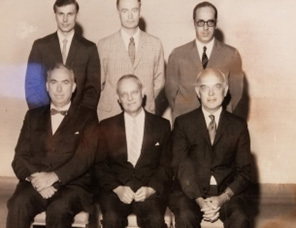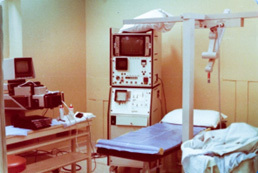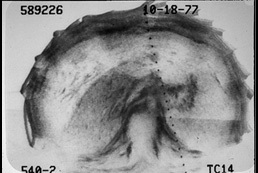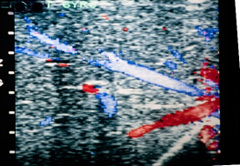Ochsner Health is a system that delivers health to the people of Louisiana, Mississippi and the Gulf South with a mission to Serve, Heal, Lead, Educate and Innovate.
History - Radiology and Diagnostic Imaging
Since the earliest days of medical imaging, New Orleans has been at the forefront of radiology advancements, with Ochsner radiologists playing influential roles in clinical practice, research, and education.
Just months after Wilhelm Röntgen’s discovery of X-rays in late 1895, Charity Hospital installed the city’s first radiology apparatus in its surgical amphitheater. The first recorded clinical use of the technology in New Orleans took place on December 23, 1896—just a year after Röntgen’s findings were published. Around the same time, Dr.C. Edmund Kells, a pioneering New Orleans dentist, became the first in the United States to use X-rays in dental practice, marking the city as an early innovator in the field.
Initially, radiology was an extension of surgical practice, primarily used to identify foreign bodies such as bullets that required removal. Photographers operated X-ray equipment for physicians, but as advancements in film, screen, and tubes improved imaging quality in the early 20th century, radiology emerged as a distinct medical specialty. Trained technologists replaced photographers in capturing diagnostic images, and board-certified radiologists took on the interpretation of X-rays. These specialists also developed and performed contrast-based examinations such as barium enemas, upper GI studies, oral cholecystograms and intravenous pyelograms, broadening the field’s diagnostic capabilities.
Over the decades, radiology at Ochsner has evolved from simple X-rays to advanced cross-sectional imaging, pioneering techniques in ultrasound, CT, MRI and PACS. Today, Ochsner’s Department of Radiology performs more than two million imaging procedures annually while continuing to expand, integrate cutting-edge technologies and lead in education and research.

Ochsner Radiology Department, 1965
Top (left to right): Roger Tutton, MD; Ralph Bergeron, MD; Mario Calonje, MD
Bottom (left to right): Seymour Ochsner, MD; Edgar Little, MD; Buell Buchtel, MD
In 1942, five visionary surgeons came together to establish the Ochsner Clinic, marking the first group medical practice in the Deep South dedicated to research and education. Recognizing the critical role of radiology in modern medicine, they appointed Dr. Edgar Little as Ochsner’s first radiologist and the head of its independent radiology department. Situated on Prytania Avenue in New Orleans, Ochsner became one of only six institutions in the region to have a certified radiologist on staff. For the duration of World War II, Dr. Little was the sole radiologist at Ochsner, laying the foundation for what would become a leading department. He continued in this role as the inaugural chair of radiology until 1961.
The following year, in 1943, Ochsner took a significant step in advancing medical education by launching its radiology residency program. Among its earliest trainees was Dr. Seymour Ochsner, who would later play an important role in the field.
By 1946, the institution expanded beyond its origins as a clinic and established its first hospital at the site of Camp Plauché, a former Army medical facility located just upriver of New Orleans. The hospital quickly became known among the nursing staff as "Splinter Village" due to the wooden floors, which often left splinters in their stockings when they removed their shoes during the hot summer months. Alongside other medical services, a small hospital X-ray department was introduced at this location, further solidifying Ochsner’s commitment to radiology.
As Ochsner continued to grow, a major milestone was reached in 1954 when the hospital relocated from “Splinter Village” to its current site at 1514 Jefferson Highway. This move allowed for expanded services and a more permanent home for the institution’s growing medical and research efforts.
A few years later, in 1957, Ochsner Clinic underwent a structural transformation, shifting from an employee-based model to an elected physician partnership. Under this new arrangement, doctors became equal partners in the institution, reinforcing a collaborative, multidisciplinary approach to patient care. Radiologists, like their colleagues in other specialties, played an integral role in this model, reflecting Ochsner’s commitment to both medical excellence and professional equity.
Through these formative years, Ochsner not only shaped the landscape of healthcare in the Deep South but also laid the groundwork for a legacy of innovation, education and patient-centered care.
PHOTO HERE - Ochsner Radiology Department, 1965Top (left to right): Roger Tutton, MD; Ralph Bergeron, MD; Mario Calonje, MDBottom (left to right): Seymour Ochsner, MD; Edgar Little, MD; Buell Buchtel, MD

Ochsner ultrasound lab with articulated arm scanner, 1977
Courtesy of Dr. Christopher Merritt

Early static transverse ultrasound image of abdomen, Ochsner 1977
During the 1960s and 1970s, Ochsner’s radiology department experienced significant growth and technological advancement. Leadership within the department evolved during this time, with Dr. Buell Buchtel serving as chairman from 1961 to 1972. He was succeeded by Dr. Seymour Ochsner, who held the position until 1977, followed by Dr. Christopher Merritt. These decades also marked the emergence of transformative innovations in medical imaging, particularly in ultrasound and computed tomography (CT).
A key miles tone occurred in 1963 when Ochsner Clinic relocated from its original Prytania Street location in New Orleans to its current site on Jefferson Highway. This move allowed for better integration of the radiology department, streamlining both inpatient and outpatient imaging services and enhancing patient care.
By 1973, Ochsner solidified its position as a leader in radiology by installing its first CT scanner. At the time, it was the first CT scanner in New Orleans, the fourth in the United States, and only the 14th in the world. This groundbreaking technology revolutionized neurocranial imaging, significantly improving the ability to diagnose and treat neurological conditions.
Further advancements followed in 1976 when Dr. Christopher Merritt introduced ultra sound technology at Ochsner. He was soon joined by Dr. Michael Sullivan and Dr. Edward Bluth, forming a pioneering ultrasound team. Their work led Ochsner to become the first institution in the nation to develop and implement a color Doppler ultrasound unit, an innovation that was later introduced nationally and internationally.
Beyond technological advancements, Ochsner remained committed to fostering a collaborative learning environment. The tradition of open reading sessions for the local radiology community continued under the guidance of Dr. Charles Nice, Jr. at Tulane University and Dr. Michael Sullivan at Ochsner. These sessions encouraged resident participation and reinforced the institution’s role in radiology education.
Between 1976 and 1977, under Dr. Merritt’s leadership, the radiology department underwent a significant expansion to accommodate both inpatient and outpatient imaging. As part of this renovation, Dr. Merritt prioritized the integration of new technology and modern equipment, further advancing Ochsner’s ability to provide high-quality, patient-centered imaging services.
Through these years of leadership, innovation and education, Ochsner’s radiology department continued to shape the future of imaging, both locally and beyond.
PHOTOS HERE Ochsner ultrasound lab with articulated arm scanner, 1977Courtesy of Dr. Christopher Merritt

One of the first color flow Doppler images of the liver in the United States, performed at Ochsner in 1986
The 1980s and 1990s marked a period of rapid expansion and technological advancement for Ochsner’s radiology department, solidifying its reputation as a leader in diagnostic imaging.
In 1985, Ochsner conducted its first MRI scan, becoming a pioneer in MRI practice within the Gulf South. This milestone ushered in a new era of advanced imaging capabilities, allowing for more precise and non-invasive diagnostic techniques.
By the late 1980s, Ochsner radiology extended its reach beyond its primary facility, opening multiple satellite offices throughout Greater New Orleans. This expansion continued across the region, with new locations established in Baton Rouge, the Northshore, and other cities throughout Louisiana and the Gulf Coast. Ochsner’s influence even extended internationally with the opening of an imaging center in Panama City, Panama, demonstrating its commitment to global medical outreach.
In 1986, Ochsner strengthened its role in medical education by launching an international MRI training center in partnership with Siemens. This program provided specialized training to 445 participants from 16 different countries, further positioning Ochsner as a hub for radiology innovation and expertise.
The 1990s brought continued progress, particularly in vascular imaging. In 1991, Drs. Christopher Merritt and Edward Bluth played a crucial role in shaping the accreditation process for vascular labs. As a result, Ochsner became one of the first institutions in the country to receive accreditation from the Intersocietal Commission, setting a high standard for vascular diagnostic services.
Technological advancements continued in 1994 when Ochsner introduced one of the first Picture Archiving and Communication Systems (PACS) in the United States. This digital innovation allowed medical images to be stored and retrieved electronically, streamlining workflows and enhancing accessibility for physicians and patients alike.
Leadership within the radiology department also evolved during this time. Dr. Christopher Merritt, who had overseen many of these groundbreaking developments, served as department chair until 1997. Dr. Michael A. Sullivan then stepped in as interim chair before Dr. Edward Bluth assumed leadership in 1998. Dr. Bluth led the department until 2006, continuing Ochsner’s tradition of excellence in radiology.
During these decades of innovation, expansion, and leadership, Ochsner’s radiology department not only advanced imaging technology but also reinforced its role as a leader in medical training and patient care, both regionally and internationally.
PHOTO HERE One of the first color flow Doppler images of the liver in the United States, performed at Ochsner in 1986
The 21st century ushered in a period of remarkable transformation for Ochsner Radiology, marked by technological advancements, institutional growth and strengthened resilience in the face of adversity.
In 2001, Ochsner Radiology became fully digital, significantly improving the turnaround time for medically sensitive diagnoses. That same year, the institution opened the Lieselotte Tansey Breast Center, the first fully integrated freestanding breast center in the region. This facility expanded radiology services beyond mammography to include high-quality breast ultrasound, localizations, and biopsy procedures, enhancing comprehensive breast care.
A year later, in 2002, Ochsner Radiology played a pivotal role in the National Lung Screening Trial (NLST),contributing to groundbreaking research that demonstrated the effectiveness of CT imaging in diagnosing early-stage lung cancer. This work reinforced Ochsner’s commitment to advancing medical knowledge and improving patient outcomes.
Under the leadership of Dr. Edward Bluth, the radiology department underwent another major renovation in 2004,modernizing its facilities and further unifying the department. However, a significant organizational shift occurred in 2005 when Ochsner Clinic’s physician partners sold their interests, dissolving the multispecialty private partnership and forming what is now Ochsner Health. Throughout the era of physician governance, two radiologists, Dr. Seymour Ochsner and Dr. Edward Bluth, had served elected terms on Ochsner’s Board of Management, ensuring the department’s integral role in the institution’s evolution.
That same year, Ochsner Radiology faced one of its greatest challenges when Hurricane Katrina devastated the Gulf South. Despite the storm’s destruction, Ochsner and its radiology department remained operational. In a display of ingenuity and perseverance, several radiologists gathered on the roof of Ochsner Medical Center to send a message: Using plastic trash bags to spell “OPEN,” they signaled to news stations and others that the hospital was still operational. This moment gained national attention during President George W. Bush’s visit to the city in the wake of the disaster.
Around the same time, Ochsner began its transformation from a clinic-based organization into a major healthcare system. That year, Ochsner acquired three local hospitals from Tenet Healthcare—Ochsner Medical Center Kenner, Ochsner Medical Center Westbank, and Ochsner Baptist Medical Center—marking the beginning of a series of acquisitions that expanded Ochsner’s footprint across the region.
In 2006, following Dr. Bluth’s transition to Emeritus Chair, Dr. Dennis Kay was appointed Chair of the Radiology Department, a role he would hold until 2024. As the system grew and acquired hospitals across Louisiana, leadership within Ochsner Radiology continued to evolve. In 2013, the Radiology Service Line was formally established to develop a cross-regional structure, and Dr. Kay assumed a new role as System Chair. Dr. Dana Smetherman was appointed as Radiology Chair of Ochsner Medical Center-New Orleans.
Over the next two decades, Ochsner incorporated more than 25 hospitals into its system. With each addition, Ochsner Radiology extended its services, integrating new facilities into its PACS system and expanding its imaging archive. Under Dr. Kay’s leadership, radiology services at Ochsner’s Baptist, Kenner, and Westbank campuses expanded to include on-site interventional radiology and breast imaging. The emergency radiology section, which began in 2011 with just two radiologists, grew into a team of 17 that now provides 24-hour coverage across Ochsner Health.
As the system grew, Ochsner Radiology also evolved to meet increasing demands. In 2011, the department transitioned from an on-call structure to full-time, 24-hour radiology coverage, ensuring continuous imaging services for patients. The introduction of new sophisticated PACS systems in 2016 allowed Ochsner to employ full-time remote radiologists, significantly expanding the department’s capacity. And in 2018 Ochsner hired its first out-of-state teleradiologist.
The department also made significant investments in infrastructure. In 2018, Ochsner opened a 20,000-square-foot freestanding imaging center across from its main hospital and clinic, further improving access to imaging services. The Outpatient Imaging Center (OIC) at Jefferson Highway became home to Ochsner’s first 3T MRI scanner. Another technology upgrade in 2019 improved the PACS system and implemented voice recognition software to improve efficiency and accuracy.
In 2024, Dana Smetherman left her role as Radiology Chair of Ochsner Medical Center-New Orleans to become CEO of the American College of Radiology. Shortly after, Cecelia Brewington, MD, joined Ochsner Health as the institution’s second Radiology Service Line Chair, succeeding Dr. Kay and ushering in a new era of leadership.
Over the past two decades, Ochsner Radiology has continually adapted to meet the challenges of a rapidly evolving healthcare landscape. From a department of approximately 17 radiologists in 2006 to a robust team of about 115 today, the department has grown exponentially, with imaging volumes surpassing 2 million exams annually across the organization. Through technological advancements, institutional expansion, and a steadfast commitment to patient care, Ochsner Radiology has solidified its place as a leader in diagnostic imaging, both regionally and nationally.

